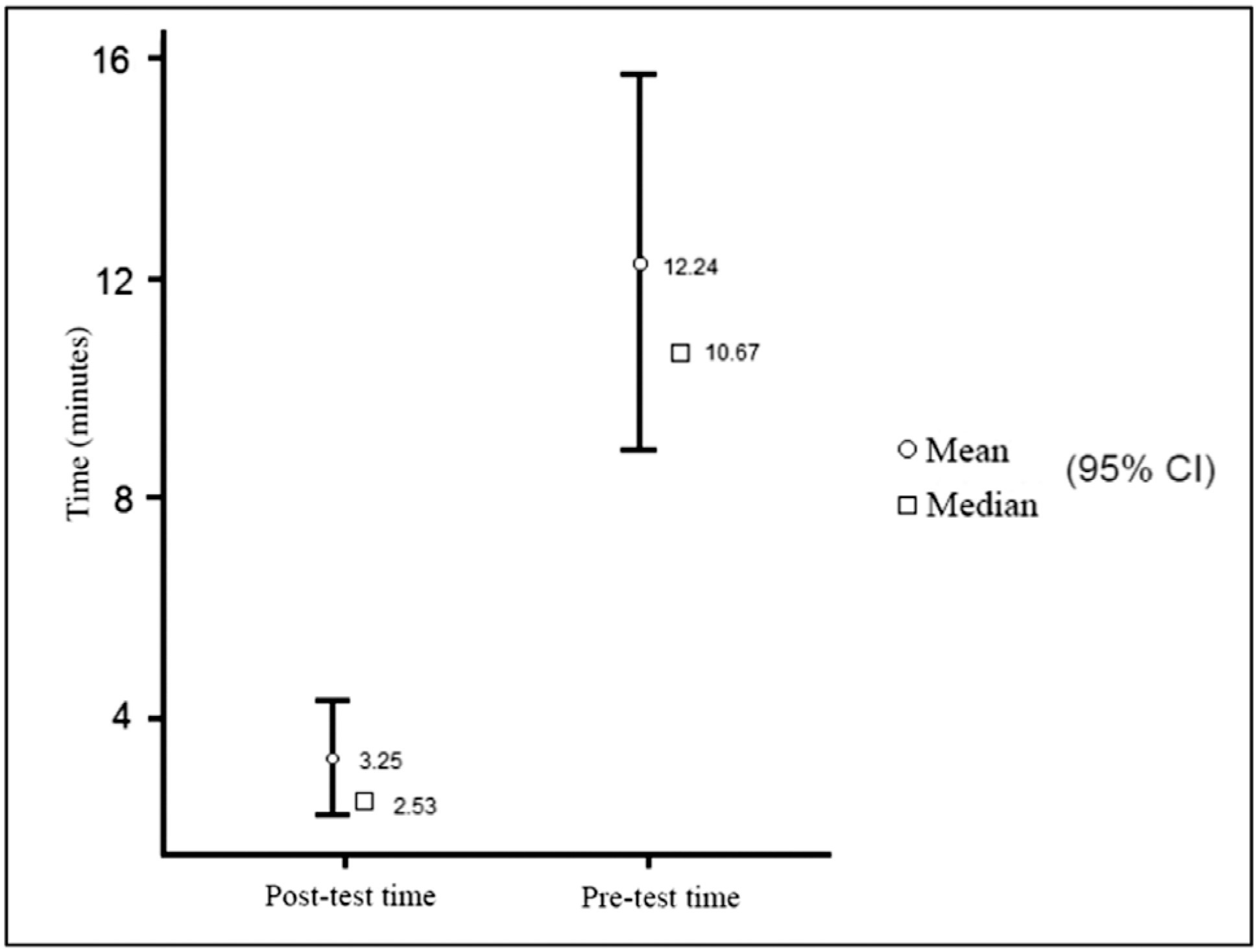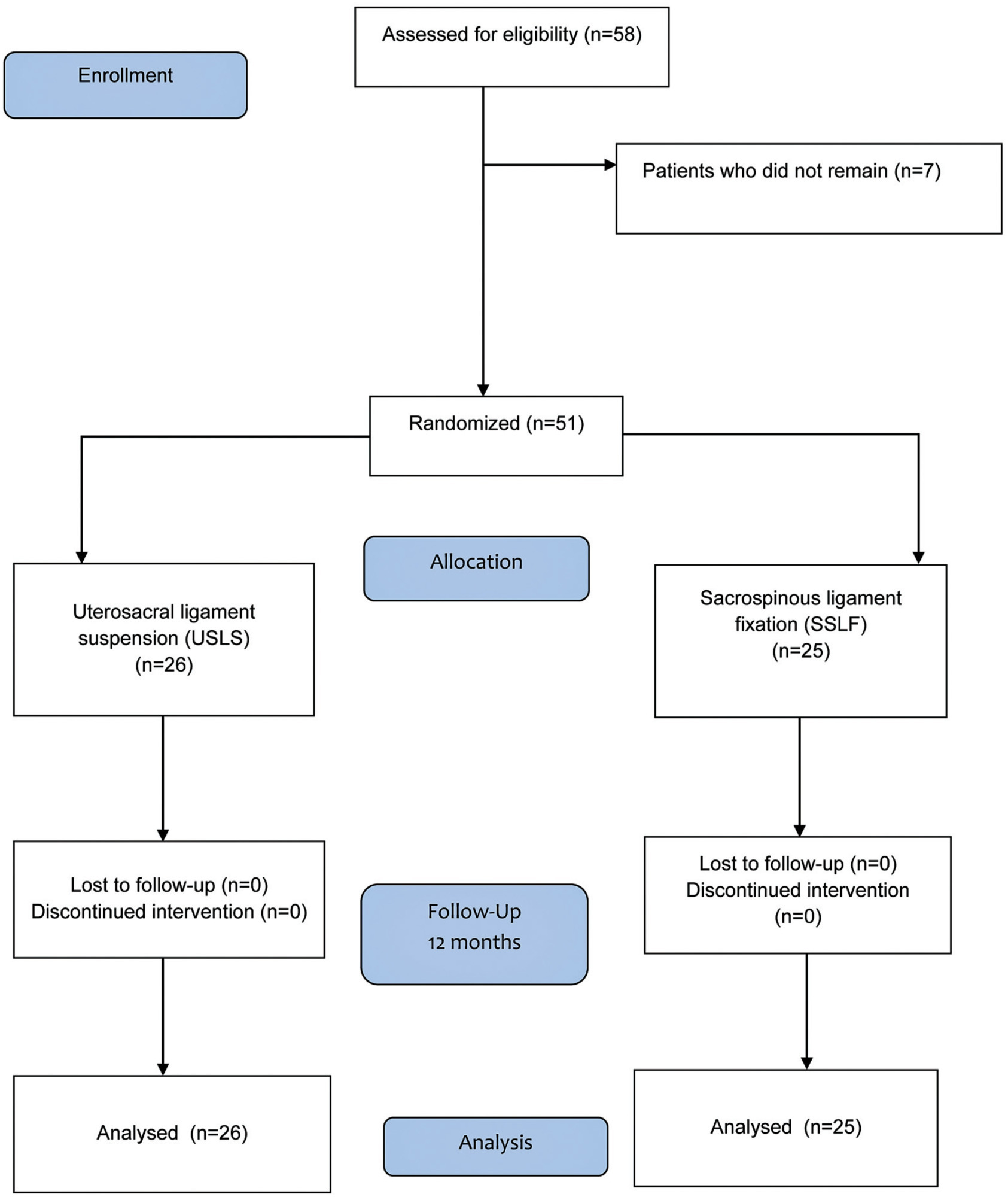Summary
Revista Brasileira de Ginecologia e Obstetrícia. 2023;45(12):747-753
To describe a cohort of placenta accreta spectrum (PAS) cases from a tertiary care institution and compare the maternal outcomes before and after the creation of a multidisciplinary team (MDT).
Retrospective study using hospital databases. Identification of PAS cases with pathological confirmation between 2010 and 2021. Division in two groups: standard care (SC) group – 2010–2014; and MDT group – 2015–2021. Descriptive analysis of their characteristics and maternal outcomes.
During the study period, there were 53 cases of PAS (24 - SC group; 29 - MDT group). Standard care group: 1 placenta increta and 3 percreta; 12.5% (3/24) had antenatal suspicion; 4 cases had a peripartum hysterectomy – one planned due to antenatal suspicion of PAS; 3 due to postpartum hemorrhage. Mean estimated blood loss (EBL) was 2,469 mL; transfusion of packed red blood cells (PRBC) in 25% (6/24) - median 7.5 units. Multidisciplinary team group: 4 cases of placenta increta and 3 percreta. The rate of antenatal suspicion was 24.1% (7/29); 9 hysterectomies were performed, 7 planned due to antenatal suspicion of PAS, 1 after intrapartum diagnosis of PAS and 1 after uterine rupture following a second trimester termination of pregnancy. The mean EBL was 1,250 mL, with transfusion of PRBC in 37.9% (11/29) - median 2 units.
After the creation of the MDT, there was a reduction in the mean EBL and in the median number of PRBC units transfused, despite the higher number of invasive PAS disorders.
Summary
Revista Brasileira de Ginecologia e Obstetrícia. 2023;45(10):557-561
We compared thyroid volume (TV) and presence of nodular goiter (NG) in pregnant vs. non-pregnant women in an iodine-sufficient area. We also evaluated the relationship between gestational age, parity, and TV in the pregnant women group, and determined the 2.5th and 97.5th percentiles of normal TV in pregnancy.
This cross-sectional study included 299 healthy women (216 pregnant) without previous thyroid diseases. Thyroid ultrasounds were performed and compared between pregnant and non-pregnant women. The range of normal distribution of TV (2.5th and 97.5th percentiles) in pregnancy was determined after excluding individuals with positive thyroid antibodies, NG, and/or abnormal serum thyrotropin (TSH) or free thyroxine (FT4).
Thyroid volume was larger among pregnant compared to non-pregnant women (8.6 vs 6.1 cm3; p< 0.001) and was positively correlated with gestational age (rs = 0.221; p = 0.001), body mass index (BMI, rs 0.165; p = 0.002), and FT4 levels (rs 0.118 p = 0.021). Nodular goiter frequency did not differ between the two groups. There was a negative correlation between TV and TSH (rs -0.13; p = 0.014). Thyroid volume was lower among primiparous compared to multiparous patients (7.8 vs 8.9; p< 0.001) and was positively correlated with parity (rs 0.161; p = 0.016). The 2.5th and 97.5th percentiles of TV were 4.23 and 16.47 cm3, respectively.
Thyroid volume was higher in pregnant compared to non-pregnant women and was positively related to parity, BMI, and gestational age in a normal iodine status population. Pregnancy did not interfere with the development of NG.
Summary
Revista Brasileira de Ginecologia e Obstetrícia. 2023;45(10):603-608
To evaluate the performance of residents in gynecology and obstetrics before and after practicing laparoscopic sutures, to establish when the training shows the best results, in addition to comparing whether being in different years of residency influences this progression.
A prospective cohort study involving 32 medical residents evaluated with a pretest to establish their previous knowledge in laparoscopic suture. This test consisted of knotting two wires, one made of polypropylene and the other of polyglactin, with a blocking sequence of five semi-knots. We set a 30-minute limit to complete the task. Then, the residents held four training meetings, focusing on suture, Gladiator rule, knot, and symmetries, in addition to executing blocking sequences. A second test to establish progress was performed.
Regarding the time spent to make the stiches using polyglactin wire, a statistically significant time improvement (p< 0.01) was observed, with a 10.67-minute pretraining median (mean 12.24 minutes) and a 2.53-minute posttraining median (mean 3.25 minutes). Regarding the stitches with polypropylene wire, a statistically significant time improvement (p< 0.05) was also observed, with a 9.38-minute pretraining median (mean 15.43 minutes) and a 3.65-minute posttraining median (mean 4.54 minutes). A total of 64.2% of the residents had been able to make the knot with polypropylene previously. One hundred percent were able to complete the task in the posttest.
Model training using the Gladiator rule for laparoscopic suture improves the knotting time with statistically similar performance, regardless of the year of residency, after systematic training.

Summary
Revista Brasileira de Ginecologia e Obstetrícia. 2023;45(10):594-602
Adhesive capsulitis is a condition characterized by shoulder pain and stiffness. Breast cancer treatment has been linked to the development of this condition, but its mechanisms are still little known. This study's objective was to identify predictors factors associated with the development of adhesive capsulitis in breast cancer patients.
A case control study was performed with women undergoing treatment for breast cancer in a single center. The sampling was nonprobabilistic and consecutive. Adhesive capsulitis was defined as constant pain associated with decreased active and passive shoulder movement in anterior elevation, external rotation at 0°/90° abduction, and internal rotation at 90° abduction. The study group consisted of patients with shoulder pain and range of motion limitations, while the control group consisted of women without any shoulder abnormalities. Sociodemographic and clinical variables were collected. A univariate logistic regression was used to assess the influence of variables on the studied outcome. For p< 0.20, a multivariate logistic regression was used. The probability of null hypothesis rejection was 5%.
A total of 145 women were assessed, with 39 (26.9%) on the study group and 106 (73.1%) on the control group. The majority was under 60 years old. In the multivariate analysis, variables correlated to the outcome under study were shoulder immobilization (OR = 3.09; 95% CI: 1.33–7.18; p = 0.009), lymphedema (OR = 5.09; 95% CI: 1.81–14.35; p = 0.002), and obesity (OR = 3.91; 95% CI: 1.27–12.01; p = 0.017).
Lymphedema, postsurgery immobilization, and obesity are predictive factors for the development of adhesive capsulitis in breast cancer patients.
Summary
Revista Brasileira de Ginecologia e Obstetrícia. 2023;45(10):575-583
In the present study, our aim was to translate, adapt, and validate the Pelvic Health History Form (a quality of life [QoL] questionnaire) of the International Pelvic Pain Society (IPPS) from English to Portuguese.
The study was approved by the Ethics and Research Committee (CEP, in the Portuguese acronym) and the IPPS. The "Transcultural Adaptation" method comprised 5 stages: translation, synthesis, backtranslation, expert review, and pretest. Cultural adaptation and validation included cognitive interviews and statistical analysis of unanswered items (> 15%) in 14 clinic patients from CPP and endometriosis clinic at Santa Casa de São Paulo.
Strong equivalences were established between the USA and Brazil questionnaires in terms of semantics, idioms, experiences, and concepts. Eighteen culturally inappropriate items were identified and adjusted using the revised response rate index. The subjective form underwent rigorous assessments, confirming its accurate measurement of intended targets.
The methodology showed efficiency and equivalence, confirming its validity. The user-friendly format and inclusion of translated, adapted, and validated instruments in Portuguese make the form valuable for evaluating pelvic health, with potential for future research.

Summary
Revista Brasileira de Ginecologia e Obstetrícia. 2023;45(10):584-593
To evaluate the efficacy and outcomes of the surgical treatment for pelvic organ prolapse (POP) in stages III and IV by sacrospinous ligament fixation (SSLF) or uterosacral ligament suspension (USLS) by comparing anatomical and subjective cure rates and quality-of-life parameters (through the version validated for the Portuguese language of the Prolapse Quality of Life [P-QoL] questionnaire) under two definitions: genital prolapse Ba, Bp, and C< −1 (stage I) and Ba, Bp, and C ≤ 0 (stage II).
After we obtained approval from the Ethics Committee (under CAAE 0833/06) and registered the study in ClinicalTrials.gov (NCT 01347021), 51 patients were randomized into two groups: the USLS group (N = 26) and the SSLF group (N = 25), with follow-up 6 and 12 months after the procedures.
There was a significant improvement in the P-QoL score and anatomical measurements of all compartments in both groups after 12 months (p< 0.001). The anatomical cure rates in the USLS and SSLF groups, considering stage 1, were of 34.6% and 40% (anterior) respectively; of 100% both for groups (apical); and of 73.1% and 92% (posterior) respectively. The rates of adverse outcomes were of 42% (N = 11) and 36% (N = 11) for the USLS and SSLF groups respectively (p = 0.654), and those outcomes were excessive bleeding, bladder perforation (intraoperative) or gluteal pain, and urinary infection (postoperative), among others, without differences between the groups.
High cure rates in all compartments were observed according to the anatomical criterion (stage I), without differences in P-QoL scores and complications either with USLS or SSLF for the surgical treatment of accentuated POP.

Summary
Revista Brasileira de Ginecologia e Obstetrícia. 2023;45(10):568-574
Pregnancy in women with lupus poses a higher risk of complications compared with the general population. The present study aimed to determine and describe the obstetric and neonatal outcomes of pregnant women with lupus.
We conducted an observational retrospective study of pregnant women with the diagnosis of lupus, who were selected and followed at the Maternal-Fetal Medicine Clinic of our institution between January 2013 and July 2018. We analyzed 59 pregnancies and 52 newborns, and collected data regarding sociodemographic features, the preconception period, pregnancy, childbirth, postpartum and the newborn. A descriptive analysis of the variables was performed.
In 58% of the cases, the pregnancy was uneventful. We registered flares in 25% of the cases, preeclampsia in 3%, fetal growth restriction in 12%, gestational loss in 10%, preterm labor in 10%, postpartum complications in 20%, and small for gestational age newborns in 17% of the cases.
Most pregnancies in women with lupus have favorable obstetric and neonatal outcomes. Prenatal counseling, adequate multidisciplinary surveillance, and optimized treatment of the disease are fundamental pillars for these good results.
